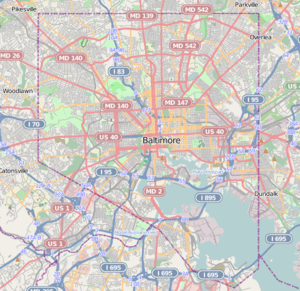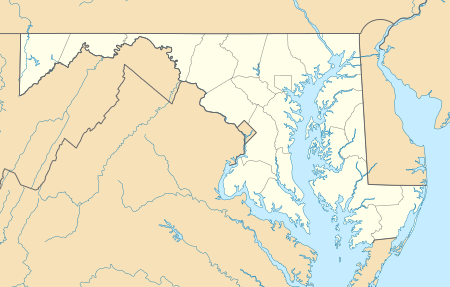Peale Museum
The Peale Museum, officially the Municipal Museum of the City of Baltimore, was a museum of paintings and natural history, located in Baltimore, Maryland, United States. It occupied the first building in the Western Hemisphere to be designed and built specifically as a museum.[3] The museum was created by Charles Willson Peale (1741–1827) and his son Rembrandt Peale (1778–1860). It functioned separately as Baltimore City's historical museum while the original structure was being rebuilt, restored, and renovated in 1930–1931, and then merged with other historic sites, houses and museums in the early 1980s under the expansive efforts of a new executive director, with the name of the Baltimore City Life Museums and a broader mission in conjunction with the other historical locations/sites/structures in Baltimore.
Peale's Baltimore Museum | |
.jpg) Peale Museum | |
   | |
| Location | 225 North Holliday Street, Baltimore, Maryland |
|---|---|
| Coordinates | 39°17′30.89″N 76°36′38.28″W |
| Built | 1814 |
| Architect | Robert Carey Long, Sr. |
| Architectural style | Georgian |
| NRHP reference No. | 66000915 |
| Significant dates | |
| Added to NRHP | October 15, 1966[1] |
| Designated NHL | December 21, 1965[2] |
After opening a new three-story exhibition gallery, uniquely using the old cast-iron façade of the razed (but placed in storage in a city yard for 30 years) Fava Fruit Company and being re-assembled on the new structure facing North Front Street and the parallel new President Street boulevard (between East Lombard and East Fayette streets), the new gallery and the B.C.L.M. ran into financial difficulties in the first year (1996–1997) after the grand opening, coincidentally during the bicentennial celebration of Baltimore's establishment as a city. The Peale branch of the City Life Museums closed with the other branches, historic houses and sites later in 1997, after being refused a one-year extension of its five-year subsidy of about $300,000 annually by then Mayor Kurt Schmoke. Its large collections from over 66 years of original existence were disassembled, transferred and handed over to the Maryland Historical Society, founded 1844, now located on the city block on the southwest corner of West Monument Street and Park Avenue, centered in the old Enoch Pratt Mansion and adjacent research library and museum exhibition areas building.[4] The building was designated a National Historic Landmark in 1965.[2]
Today, the museum is being renovated and relaunched as the Peale Center for Baltimore History and Architecture through a partnership between Baltimore's Department of General Services, which owns the building, and the Board of the Peale Center for Baltimore History and Architecture, a 501(c)(3) tax-exempt, non-profit corporation. It is closed due to the COVID-19 pandemic, but anticipates re-opening soon.
History
Charles Willson Peale (1741–1827) received his inspiration for a public museum in 1783 while illustrating mastodon fossils belonging to Dr. John Morgan. Once he had conceived the idea for an American museum of natural history, Peale opened a museum to the public in Philadelphia on July 18, 1786. In 1810, Peale retired from his work with the museum, leaving its management and responsibility to his sons. Later in 1814, a museum was established at 225 North Holliday Street between East Saratoga and East Lexington streets in Baltimore by Rembrandt Peale (1778–1860), the second son of Charles Willson Peale. It was dubbed as "Peale's Baltimore Museum and Gallery of Fine Arts" and featured portraits of famous Americans (many by the founder) and the complete skeleton of a prehistoric mastodon exhumed by C.W. Peale in 1801.
In 1830, the old Peale Museum was sold and the exhibits were moved to a newly constructed building on the northwest corner of North Calvert Street and East Baltimore Street, one block south of the Battle Monument Square and the Baltimore City Courthouse. By 1830, the historic building became home to Baltimore's first "City Hall" and remained there through the tumultuous Civil War years until 1875 when replaced by the current Baltimore City Hall, which had been under construction since 1867 one block south, on the 200 block of Holliday Street. The massive new municipal government offices of French Second Empire-style architecture, with its distinctive mansard roofs and large dome and clock, now occupied an entire city block bounded by Holliday, East Lexington, East Fayette and North streets (now Guilford Avenue), one block south at the 200 block of Holliday between East Lexington and Fayette streets.
The old museum and City Hall was then turned over to the city's Board of School Commissioners and the Baltimore City Public Schools and became the Number 1 Colored Primary School (as there was a number of then-called "Negro" or "Colored" institutions, churches, law firms and businesses in the areas around East Pleasant, Saratoga, East Lexington and along St. Paul Street and North Calvert streets). Later it was rented out to a series of private businesses.
By 1928, it had been repeatedly condemned and was in danger of demolition. With the inspiration of newly-emergent, local historians and journalists, who had just celebrated the centennial of the "Star Spangled Banner" (future national anthem) and the Battle of Baltimore with its Bombardment of Fort McHenry and resulted in the saving of the old 1793 rowhouse at East Pratt and Albemarle streets in the Jonestown/Old Town and Little Italy neighborhoods, owned and lived in by Mary Young Pickersgill, (1776–1857) who made the huge "Star Spangled Banner Flag", the restoration of the old "Flag House" and setting up of a historical museum there in 1927 boosted the hopes, political power and determination of the preservationists. So the restoration of the old museum took place with an expense of $90,000. The building was renovated and rededicated in 1931 as the Municipal Museum of Baltimore. The museum underwent a major two-year renovation starting in 1978 and was reopened in 1981 as the Peale Museum. In 1985, the Peale became part of the Baltimore City Life Museums system until its closure in 1997.
The entire Peale collection has been moved to the Maryland Historical Society, leaving the original building on North Holliday Street vacant.
As of April 2014, a campaign was being waged by a Maryland group to raise $4 million for restoration of the museum.[5] The building is located between Zion Lutheran Church and offices for The Real News.
References
- "National Register Information System". National Register of Historic Places. National Park Service. January 23, 2007.
- "Peale's Baltimore Museum". National Historic Landmark summary listing. National Park Service. Archived from the original on 2012-10-10. Retrieved 2009-03-30.
- Mendinghall, Joseph S. (February 28, 1975). "National Register of Historic Places Inventory Nomination: Peale's Baltimore Museum". National Park Service. Retrieved 2009-03-30.
- "Baltimore City Life Museum Photo Collection". Maryland Historical Society. Archived from the original on 2010-04-17. Retrieved 2009-07-27.
- Wenger, Yvonne (April 4, 2014). "New life envisioned for old Peale Museum downtown". The Baltimore Sun. Retrieved January 9, 2015.
External links
| Wikimedia Commons has media related to Peale Museum. |
- Peale's American Museum information from the Academy of Natural Sciences
- Rembrandt Peale Museum, 225 North Holliday Street, Baltimore, Independent City, MD at the Historic American Buildings Survey (HABS)
- Peale Museum – Explore Baltimore Heritage
- Peale's Baltimore Museum, Baltimore City, including undated photo, at Maryland Historical Trust

